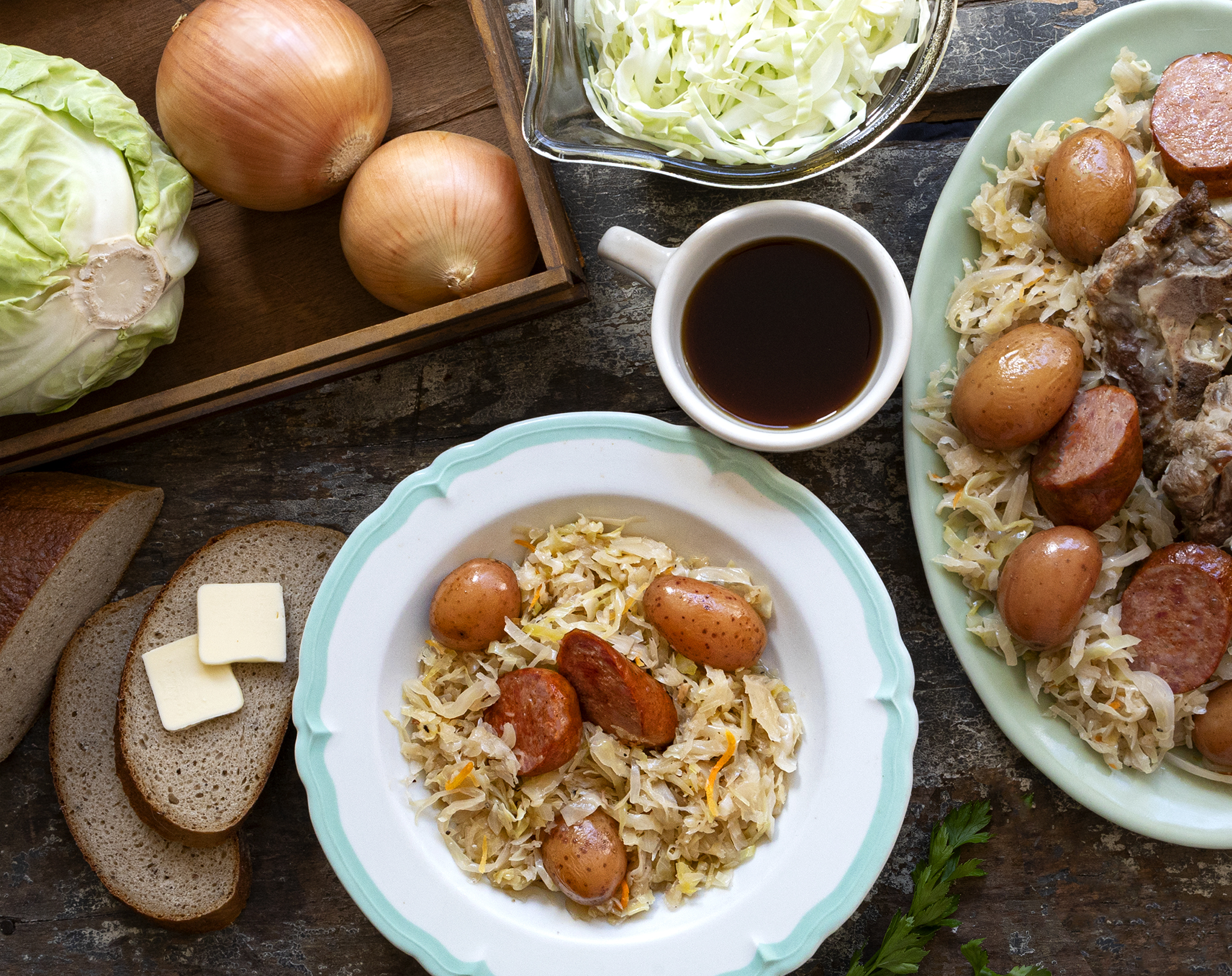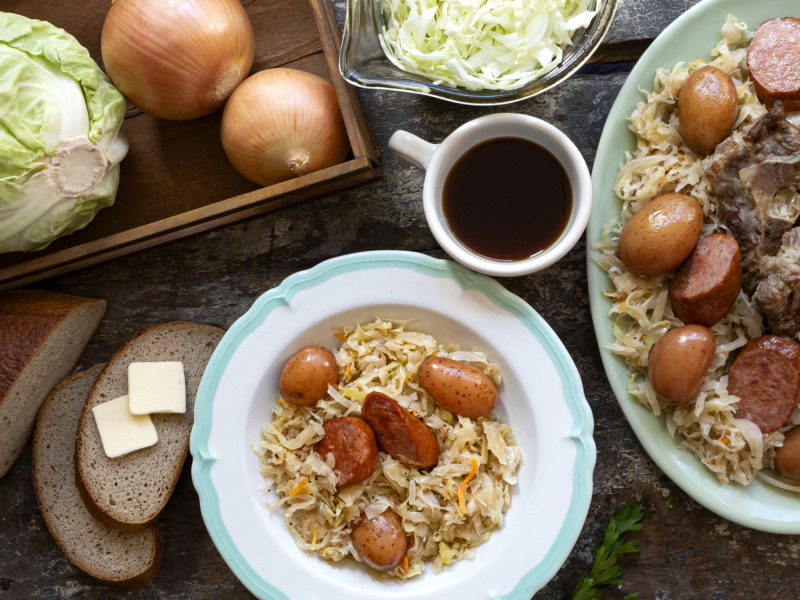Ask my 95-year-old dad Bob about food memories and he is sure to tell you about sauerkraut. His mom (my Grandma Lydia) had a big barrel on the back porch of the family’s flat on Chicago’s south side. About this time of year, she would fill that barrel with fresh cabbage to make sauerkraut. Sometimes, the cabbages came from dad’s childhood business, selling vegetables from a wagon he pulled up and down the alleyways with his brother Emil. Other times, Grandpa Albert bought them from a truck farmer. Either way, making sauerkraut was a family affair: Grandpa sliced the cabbage with a metal-bladed contraption fitted over a washtub. Grandma gathered up the shreds, put them in the barrel and sprinkled handfuls of salt over all at practiced intervals. Between each addition, dad and Emil would get to work with a huge wooden pestle, (they called it a “stomper”) pounding down the cabbage to release its juices. Once the barrel was nearly full, a piece of wood, sized to nestle inside the barrel top, was weighted down with a heavy stone, the barrel was rolled onto the porch, and the cabbage left to naturally ferment in the cool air. It transformed over a few weeks into proper sauerkraut.
“We ate it almost every day during the Fall and Winter—all the way through to the Spring,” says Dad. “Mom would scoop out portions of the sauerkraut and cook it with pork neck bones or other inexpensive cuts of meat, which added good flavor. We usually had it with some boiled potatoes and always rye bread.”
Decades later, my mom made sauerkraut dinners, too. But we didn’t have that big barrel, and mild, naturally fermented cabbage wasn’t sold at the store to use as the base of the dish. So, mom used whatever bottled kraut she could find– often, with a taste more sour than she and dad liked. To mellow the flavor of bottled kraut, mom would rinse it, and then add fresh cabbage sauteed with onion, and a little caraway seed, cooking it all in a big pot as grandma had, with pork neckbones. Served with fresh rye bread, buttered potatoes, and some sausage on the side, it was a delicious, homey meal.
Today, fresh, naturally fermented sauerkraut can be found in the refrigerated aisle at the grocery store. I mix that with a pound of mild German bottled sauerkraut, plus a head of shredded cabbage, onion, and pork neckbones for this recipe. If you can’t find fresh naturally fermented kraut, either use two bottles of the mild German variety, or choose whatever bottled brand you can find that has only cabbage and salt listed as the ingredients. If the brand you source is very sour, rinse it well with cool water before cooking. And for a yummy way to use any extra sauerkraut from this recipe, try my Pork Chops with Sauerkraut and Apple Stuffing!
Ingredients
- FOR THE SAUERKRAUT:
- 1, 1-lb container of fresh, uncooked, naturally fermented sauerkraut plus 1, 1-lb bottle of mild, German sauerkraut (Hengstenberg Authentic German Sauerkraut is a good one)
- OR 2, 1-lb containers of fresh, uncooked, naturally fermented sauerkraut (I use Chicago Famous Sauerkraut from A-Z Sales Inc.)
- 1 ½ pounds (six to eight pieces) meaty pork neckbones, fat discarded
- 3 Tbsp vegetable or olive oil, divided
- 1 small head of cabbage (core and outer leaves discarded,) shredded
- 1 onion cut in thin slices to make 2 cups
- 1 Tbsp pepper
- 2 tsp salt
- 1 tsp caraway seed (optional)
- FOR THE BUTTERED POTATOES AND SAUSAGE:
- 2 pounds small red potatoes, boiled
- 1 pound Polish sausage, steamed and sliced
- ¼ cup butter
- 2 Tbsp fresh minced parsley, to garnish potatoes
Instructions
- Preheat oven to 400. Place pork neckbones in an ovenproof casserole dish. Rub bones with salt and pepper; drizzle with 1 Tbsp oil. Place neckbones in oven and brown for 20 minutes.
- While neckbones brown, in a large soup kettle over medium-low heat, cook onion and cabbage with the remaining 2 Tbsp oil until softened; stirring frequently and adding ¼ cup water (as needed) to prevent browning. Add neckbones, caraway, lightly rinsed bottled sauerkraut (if using) and unrinsed fresh, naturally-fermented sauerkraut. Mix well. Add two cups water. Cover. Simmer over low heat for 1 ½ hours or until meat is tender, and flavors have melded well, removing lid to stir occasionally. Adjust seasoning with salt and pepper to taste. Serve sauerkraut hot with buttered potatoes, sliced Polish sausage and fresh rye bread. Note: If desired, you can pick the meat from the pork bones to mix into the kraut.





1 Comment
Hello! Thank you for sharing your wonderful story. I must say that I believe in eating fermented sauerkraut (and pickles). They’re good for our gut! However, I BAKE my neckbones and sauerkraut. I actually use canned sauerkraut. I put my fresh neckbones in a casserole, Pyrex dish, pour two large cans of sauerkraut on top, distribute evenly and sprinkle with CELERY SEEDS. I cover with aluminum foil and and bake at 350 degrees for about two hours, give or take. Good eating!